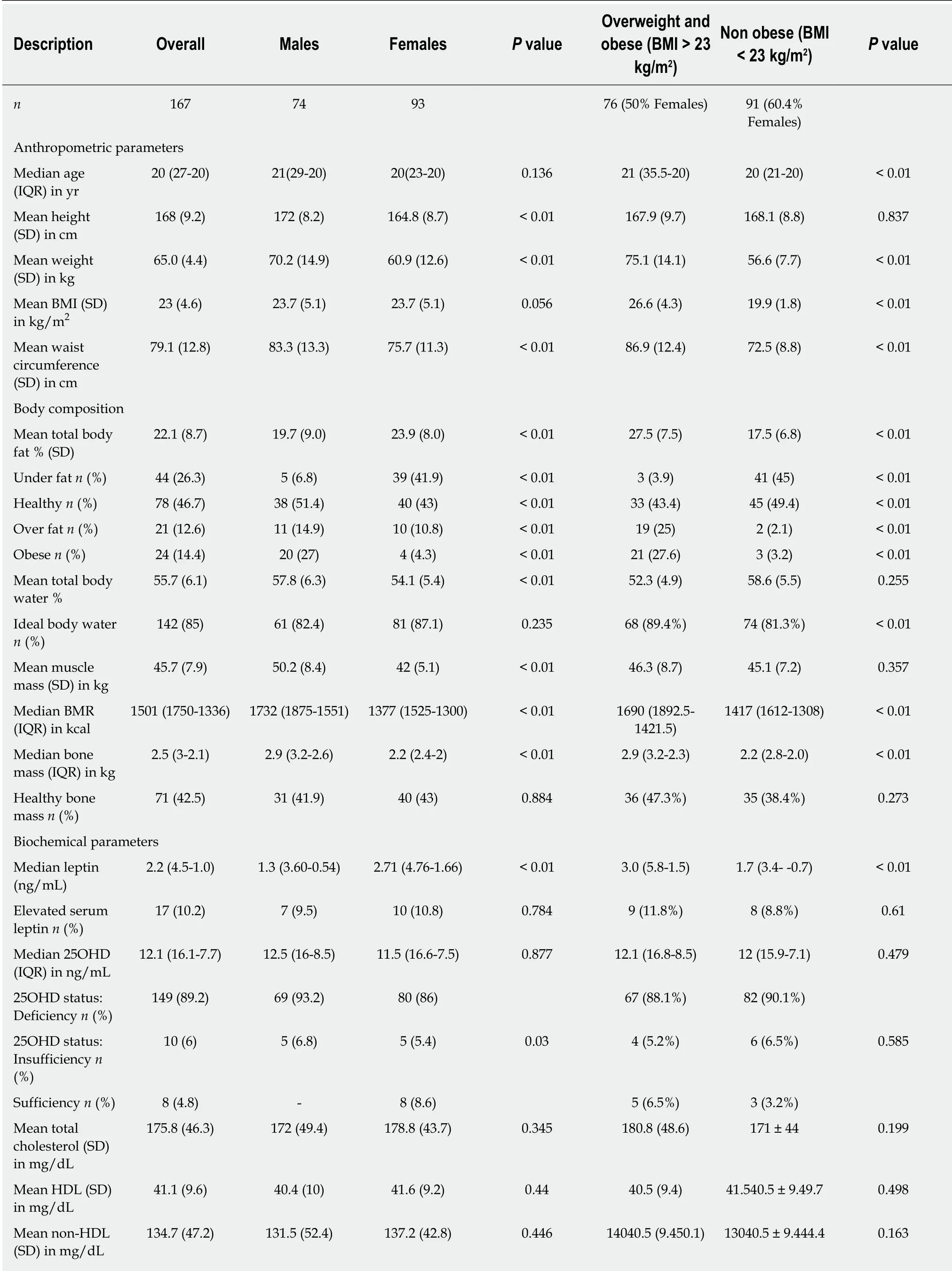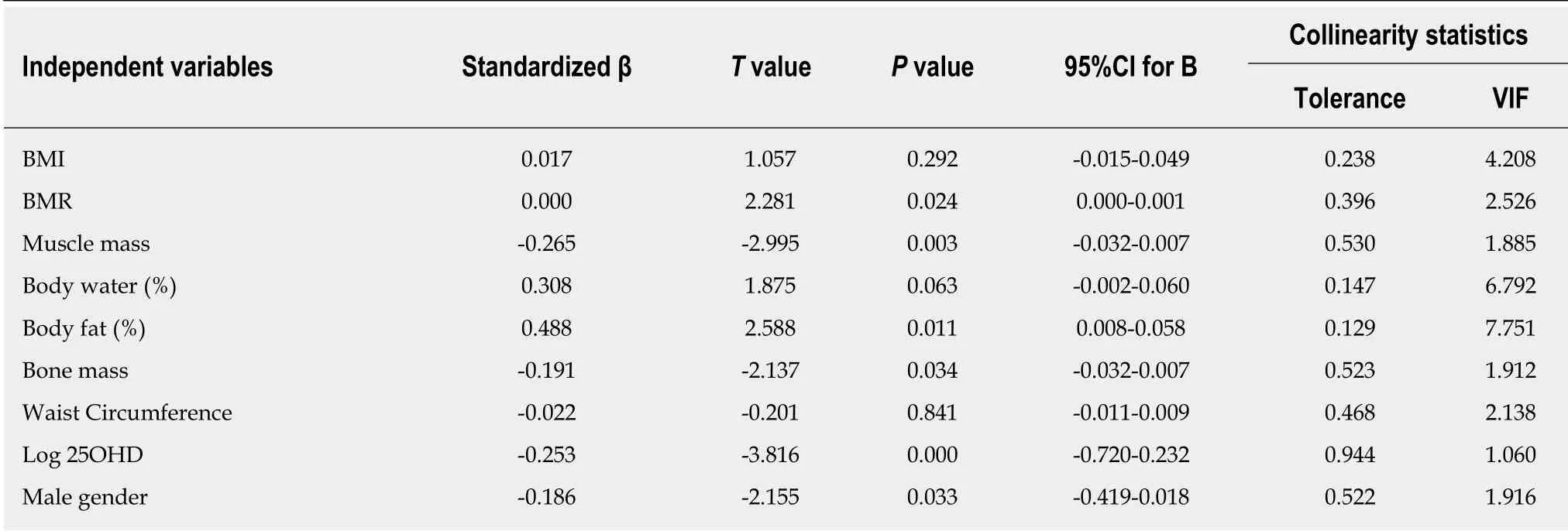Are serum leptin levels predicted by lipoproteins,vitamin D and body composition?
2019-04-24AyshaHabibKhanSyedaSadiaFatimaAhmedRaheemLenaJafri
Aysha Habib Khan,Syeda Sadia Fatima,Ahmed Raheem,Lena Jafri
Abstract
Key words: Leptin;Vitamin D;Obesity;Vitamin D deficiency;Body fat
INTRODUCTION
Quite a few cross-sectional studies have explored leptin and obesity in relation to Vitamin D deficiency (VDD) but the findings is inconsistent and conflicting[1-4].The limited available literature differs considerably in terms of study design,subjects studied and results reported,making it challenging to infer.The cause-effect relationship between leptin,VDD and obesity remains unclear.The link between vitamin D and obesity has been put forward by some genetic and secondary lines of evidences[5-7].Secondary factors common to both obesity and VDD are environmental aspects like dietary,racial,topographical,seasonal,and environmental pollution[8-10].Genetic studies have shown to link molecular variations of Vitamin D metabolism with obesity[11-13].The hereditary risk factors include polycystic ovary disease,cytochrome P450,locus 20q13,vitamin D-binding protein gene polymorphisms,andaP2gene.The VDR polymorphisms were described to be linked to adiposity phenotypes[14,15].
Given the potential for positive associations of VDD and leptin concentration with obesity and the development of cardiovascular disease,the identification of modifiable lifestyle factors associated with leptin levels is vitally important to prevent obesity and its associated complications[16].Additionally,the connection between body composition,especially fat content in the body,and Vitamin D and leptin in young adults is clinically vital because management that modify body weight may affect bone health and therefore the possibility of osteoporosis in later life.Few studies have attempted to investigate the effect of body composition and leptin with vitamin D in adolescence[17,18].This study was conducted to analyze serum leptin concentrations in samples from adult volunteers and correlate it with body composition parameters,difference in gender,25-hydroxy vitamin D (25OHD) and lipids.
MATERIALS AND METHODS
Study design and study group
This cross sectional analysis was done from June 2014 till January 2016,in the Section of Clinical Chemistry,Department of Pathology and Laboratory Medicine and Department of Biological and Biomedical Sciences,Aga Khan University Hospital Karachi Pakistan.Apparently healthy adult volunteers were invited to join in the research once informed consent was taken.Approval from the Aga Khan University Ethical Review Committee was taken for conducting this study (ERC number:2810-Pat-ERC-13).A 4-d phlebotomy camp was set up in the Multidisciplinary Laboratory on the University campus for collection of blood samples.Subjects were excluded if they reported having had:intramuscular supplementation of Vitamin D in the last 6 mo,remarkable changes in weight or diet in the last 6 mo,any disease that may affect their Vitamin D levels or any known metabolic disorder.Subjects taking small dose of oral Vitamin D supplements,for example such that may be contained in a daily multivitamin pill (400 IU) since such a low amount would not significantly change serum 25OHD levels,were allowed to participate[19].
Clinical history,anthropometric measurements and phlebotomy
An interviewer-administered history form tailored for the adult Pakistani urban population[20],was used to assess the clinical history and health status of the study group.Waist circumference was measured in cm.Each subject’s weight (kg) and height (m) were recorded,and the resultant body mass index (BMI) was calculated and reported in kg/m2.BMI values were categorized as per the recommended reference ranges for the Pakistani population[21].A bioelectrical impedance analyzer(BIA) by Tanita was used to assess body composition variables of the study group.BIA is a validated method of estimating adiposity in both clinical and non-clinical settings[22].BIA measurements included total body fat percentage (reported as %),total body water percentage (reported as %),total muscle mass (reported in kg),basal metabolic rate (reported in kcal) and total bone mass (reported in kg).International body fat reference ranges for young adults were used to group subjects.
After informed consent blood was drawn in gel separation tubes and centrifuged at 3500 rpm for 5 min for separation of serum.Separated serum was transferred to aliquots,labeled with the participant’s serial number and immediately stored at -30°C.
A BIA was used to assess body composition variables of the study group.BIA is a validated method of estimating adiposity in both clinical and non-clinical settings[22].BIA measurements included total body fat percentage,total body water percentage,total muscle mass,basal metabolic rate and metabolic age,total bone mass and visceral fat mass.International body fat reference ranges for young adults were used to group subjects.
Biochemical analysis and interpretation
Leptin was measured using manual ELISA on a kit from DIA source (Belgium).The microtiter wells were coated with a monoclonal anti-leptin antibody.25OHD was quantified by chemiluminescence on ADVIA Centaur Immunoassay System (Siemens AG,Munich,Germany) in batch.The measuring range of the assay was 3.7-150 ng/mL.Total cholesterol was measured using an enzymatic endpoint method,while cholesterol oxidase-phenol aminophenazone method was used for analysis of high density lipoprotein (HDL) cholesterol by using kits from Randox Laboratories,United Kingdom on spectrophotometer.Non HDL was calculated by subtracting HDL from total cholesterol.To validate the biochemical results high and low levels of quality control material for leptin,25OHD,cholesterol and HDL were run with the batches.Classification of VDD was based on the circulating 25OHD concentrations of less than 20 ng/mL.Levels between 20-30 ng/mL as insufficiency and > 30 ng/mL as sufficient D levels.Serum leptin was interpreted taking both BMI and gender into account.
Statistical analysis
All Statistical analysis was done on R-Software (R Version 3.5.3) and Statistical Package for Social Sciences (Version 22,SPSS Inc.Chicago,IL.).All parametric variables were reported as mean ± SD and non-parametric as median with interquartile ranges 75th-25th.Differences between two groups of parametric variables were evaluated using independent samplest-test.To compare median values between two groups Mann WhitneyUtest was applied.Serum leptin and 25OHD were not normally distributed and hence were log transformed before correlation was conducted.As an initial step,we explored Pearson correlational relationships and applied Chi-square for categorical data between the measured independent variables taking serum leptin as dependent variable.Univariate analysis was conducted and variables that had significant association with leptin in univariate analysis atP< 0.2 were entered in multivariable analysis.Multivariate regression analyses were conducted for the dependent variable (serum leptin) and independent variables [BMI,basal metabolic rate (BMR),muscle mass,body water %,body fat %,bone mass,waist circumference,log 25OHD,male gender].For working out the magnitude of associations between independent-dependent variables,beta weight of the variables was calculated.All tests were two-tailed,and the level of significance was set toPvalue less than 0.05 as significant and < 0.01 was considered greatly significant.
RESULTS
Description of demographics and body composition of study group
A total of 167 subjects were enrolled;there was a near equal gender distribution with Female:Male 93:74.No statistically significant difference for age was found between the two genders.None of the subjects studied had any clinical signs of disease associated with obesity and were not on any medications.Of the total seven were cigarette smokers (4.1%);2 smokers were females and the rest were males.Characteristics of the study population are summarized in Table 1.
No statistically significant difference in BMI between males and females was noted however,the male adolescents had significantly higher body height and weight than their female counterparts (P< 0.001).According to the South-Asian Classification of weight status,14.4% (n= 24) of the study-subjects were categorized as underweight(less than 18.5 kg/m2),40.1% (n= 67) as normal (from 18.5 to 22.9 kg/m2),22.2% (n=37) as overweight (from 23 to 25 kg/m2) and 23.4% (n= 39) as obese (greater than 25 kg/m2).
Taking age and gender into account study subjects were additionally stratified according to body fat percent as under fat,healthy,over fat and obese.Upon stratification according to body fat percent 14.4 % (n= 24) were obese while 12.6% (n= 21) were overweight.Body fat % was significantly higher amongst subjects who were overweight and obese as per BMI [mean body fat %:27.5 (7.5)] as compared to non-obese [mean body fat %:17.5 (6.8)] as depicted in Table 2.Percent of body water in study subjects was ideal (i.e.,45%-60% in females and between 50%-65% in males)in 80% subjects (n= 142),low in 6% (n= 10) and excessive in 9% (n= 15).
Biochemical specifics of study subjects
A Shapiro Wilk test (P< 0.05) and visual scrutiny of 25OHD and leptin histograms,QQ plots and box plots showed that both analytes were not normally distributed,with a skewness of 1.8 (S.E 0.18) and 3.5 (S.E 0.18) respectively and kurtosis of 5.9 (S.E 0.37)and 17.4 (S.E 0.37) respectively.Majority (89.2%,n= 149) of the study group was 25OHD deficient,6% (n= 10) had insufficient serum 25OHD levels and 4.8% (n= 8)had sufficient D levels.Of a total of 167 sera analyzed,the lowermost and uppermost serum leptin levels noted were 0.02 and 45.3 ng/mL,respectively.Females had higher median leptin levels [2.71 (IQR:4.76-1.66 ng/mL)] compared to males [1.3 (3.60-0.54 ng/mL),P< 0.01].Overall 17 (10.1%) study subjects had raised serum leptin levels with 88.2% (n= 15) of these subjects being Vitamin D deficient.However,89.3% (n=134) of the subjects with normal serum leptin were also deficient in 25OHD.
Determinants of serum leptin
The Table 2 describes the relevant Pearson correlation coefficients and their degrees of significance between leptin and other variables in the total study population and in both genders separately.A greatly significant,moderate positive linear relationship was seen between log of leptin and BMI,waist circumference and also with total body fat percent in females (P< 0.01).While a greatly significant negative association was prominent between log of serum leptin and total water percent and basic metabolic rate in the females (P< 0.01).In males log leptin exhibited positive relation with BMI(P< 0.05),waist circumference (P< 0.05) and body fat percent (P< 0.01) and inverse correlation with total water percent,muscle mass and log 25OHD (P< 0.01).Variables that had significant association with leptin in univariate analysis atP< 0.2 were entered in multivariable analysis.
Multiple regression analysis displayed that BMR,muscle and bone mass,body fat percent,25OHD and gender were the utmost contributing factors to serum leptin levels.Bone and muscle mass and serum 25OHD bore an inverse relation with serum leptin.The value of R square and adjusted R square was 0.387 and 0.352 respectively specifying strong association between various independent and dependent variables.This showed a positive relationship of 38.7% between independent and dependent variable (leptin).Corrected R square indicated the fit of the model more closely in population.Table 3 summarizes the results of multivariate regression analysis.Itshows that among various parameters (like BMR,female gender and bone mass)which were contributing towards leptin levels body fat percent with standardized beta weight of 0.488 was the most influential factor in leptin values followed by muscle mass (beta of -0.265) and 25OHD (beta of -0.253).Body mass index,waist circumference and body water percent were not good predictors for serum leptin.Statistics from multi-collinearity displayed tolerance < 10 indicating good associations with leptin.Moreover,muscle mass,bone mass,25OHD and male gender showed a negative influence on leptin levels.

Table 1 Demographics,body composition and biochemical parameters and comparison amongst genders and obese vs non obese

Table 2 Correlation of metabolic and biochemical factors with serum log leptin according to gender distribution
DISCUSSION
This study explored variables like anthropometric measurements,body composition,25OHD and lipoproteins as predictors for serum leptin levels among representative population of healthy adults in Pakistan.Majority of the subjects were D deficient(89.2%).This is not surprising as previous published papers have shown high prevalence of VDD both in Pakistanis living abroad or residing in Pakistan[23,24].Pakistan is among the sun-drenched countries and cutaneous production of vitamin D is possible throughout the year.However,despite this favorable climatic condition,research reports from our center showed widespread VDD[25-28].Serum 25OHD showed non-significant and poor association with BMI in this study;contradicting to reports from other part of the world which showed inverse relationship of vitamin D with BMI[4].The proposed hypothesis for could be attributed to Vitamin D lipophilic nature,that leads to 25OHD storage or sequestration in fat tissue.This volumedistribution effect could result in diminished vitamin D bioavailability and VDD in those with extra body weight.Reason for poor association of 25OHD with BMI could be that majority of our population was deficient in Vitamin D.Relationship could not be established as even non-obese subjects in this study were D deficient (88.7%).Similar trend was observed in previous study by our group,yet low vitamin D did not depict any change in BMD which may highlight the bone mineralization effects of raised leptin[29].
Obesity has been associated with both leptin and VDD[30,31].Leptin regulates body fat mass and has a significant role in the control of body weight[32].Leptin is directly associated with fat mass,circulating leptin molecules carry information to the brain(hypothalamus) regarding the energy stored in adipose tissue,diminishing appetite and affecting energy expenditure[33].The receptors of leptin molecules are found in all places in the body indicating a general role[34].Obesity is considered a leptin resistant state resulting in excessive growth of adipose tissue and high serum leptin levels.An indirect effect is of UVB radiation exposure and the latitude gradients on VDD and obesity.Hoseinzadehet al[10]confirmed that the topographical factor varied with the variation in vitamin D levels in obese and the prevalence of VDD among African-American children and adolescents were 57% and 48.7% in Pennsylvania (latitude 40oN) and Wisconsin (latitude 43oN),respectively.
Going at par with VDD,obesity is also becoming a fast-growing health concern in Pakistan.Surplus body weight is a risk factor for many medical diseases,including cardiac disease,diabetes,arthritis and several cancers.According to recent studies,overweight and obesity have been shown to be related to low vitamin D status.For instance,according to a study in Oslo,Norway,the prevalence of VDD was highest in individuals with greater BMI regardless of their gender.Accumulatingepidemiological evidence suggests that hypovitaminosis D may be associated with obesity and related metabolic risks[35].The levels of 25OHD are associated with BMI,declining with increasing BMI[36].This is because adipocytes take up the Vitamin D from the blood,hence reducing the serum Vitamin D concentrations.This indicates that there is a link between Vitamin D levels and BMI which is a measure of relative weight based on an individual's mass and height.Hence,we hypothesized that lower Vitamin D levels would be noted with increasing BMI status among healthy individuals.

Table 3 Multiple regression analysis of serum leptin determinants
Similar to our study findings multiple studies have reported higher levels of leptin in females and this can be explained by differences in sex hormones[37,38].Our study findings showed that male gender inversely contributed towards leptin levels with standardized beta weight of -0.253.
The present study has few limitations.Firstly,it was a cross sectional study hence causal relationship between leptin and other variables could not be determined.Secondly,the sample size was limited to predict any valid conclusion for a large set of population.Some gender-specific interlink was also noted,but absence of data of follicle stimulating hormone,luteinizing hormone,estradiol and testosterone levels could not allow the confirmation of this hypothesis.However,the study overall adds to the scientific knowledge of the burden of vitamin D in relation to healthy individuals.
In conclusion,this cross sectional study confirmed the relation between basal metabolic rate,muscle mass,body fat percent,bone mass,serum 25OHD and serum leptin levels.Additional studies are obligatory to define the role of hypothalamic control of body in bone formation.Elucidation of such mechanism may lead to a novel therapeutic approach to osteoporosis.Another question that remains unanswered is whether overweight/obese requiring more intense vitamin D supplementation to achieve optimal levels of 25OHD.It will also be interesting how weight loss or vitamin D treatment could affect leptin levels in this population.
ARTICLE HIGHLIGHTS
Research background
Obesity is considered a leptin resistant state leading to elevated leptin levels.Obesity in turn has also been linked to Vitamin D deficiency (VDD).
Research motivation
Going at par with VDD,obesity is also becoming a rapidly growing health problem in Pakistan.Obesity has been associated with both leptin and VDD.Few studies have attempted to investigate the effect of body composition and leptin with vitamin D in this part of the world.
Research objectives
We investigated the relation of serum leptin with body composition,lipids and vitamin D in adults.
Research methods
In a cross sectional study design bioelectrical impedance analysis was performed on 167 apparently healthy adults along with recording their demographics and clinical history.Blood was drawn for biochemical analysis of serum leptin,total vitamin D,total cholesterol and HDL cholesterol.
Research results
Majority of the study group was vitamin D deficient.Females had higher median leptin levels compared to their counterparts.Overall 17 (10.1%) study subjects had raised serum leptin levels with 88.2% of these subjects being Vitamin D deficient.Basic metabolic rate,muscle mass,bone mass,body fat percent,lipids and 25-hydroxyvitamin D (25OHD) and gender were associated with serum leptin levels.Bone and muscle mass and serum 25OHD bore an inverse relation with serum leptin.
Research conclusions
The cross-sectional nature of this study could not elucidate causal relationships.However,it outlines important interplay between circulating leptin,vitamin D and body composition.The results indicate that basal metabolic rate,muscle mass,body fat percent,bone mass and serum vitamin D have an impact on serum leptin levels.25OHD did not vary between obese and nonobese.This probably could be because > 80% of the study group was D deficient.
Research perspectives
Future studies addressing the causal relationships between these essential molecules,leptin,vitamin D and lipids is needed to better understand their use as biomarkers of risk for obesity and diseases associated with obesity.
杂志排行
World Journal of Diabetes的其它文章
- Pharmacologic adjunctive to insulin therapies in type 1 diabetes:The journey has just begun
- Risk factors in patients with type 2 diabetes in Bengaluru:A retrospective study
- Management and control of type 2 diabetes mellitus in Lebanon:Results from the lnternational Diabetes Management Practices Study Wave 6
